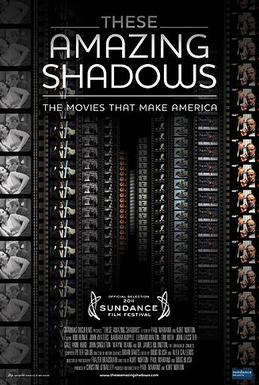 I recently watched These Amazing Shadows (2012) based on Andy Rush’s recommendation and it got me extremely intrigued with the criteria for getting a film on the National Film Registry, what exactly does “artistically, culturally, and socially significant” mean? Seems like these three terms as criteria could frame an entire semester of inquiry for a movie MOOC 😉 What’s more, it would enable us to approach this idea of significance from a variety of different genres: narrative, documentaries, instructional, home movies, avant-garde, shorts, newsreels, animation, etc.
I recently watched These Amazing Shadows (2012) based on Andy Rush’s recommendation and it got me extremely intrigued with the criteria for getting a film on the National Film Registry, what exactly does “artistically, culturally, and socially significant” mean? Seems like these three terms as criteria could frame an entire semester of inquiry for a movie MOOC 😉 What’s more, it would enable us to approach this idea of significance from a variety of different genres: narrative, documentaries, instructional, home movies, avant-garde, shorts, newsreels, animation, etc.
I’m currently working on a draft version of the syllabus for such a course that would ideally be taught in conjunction with the Library of Congress, Packard Campus, and I am thinking about how the class might be structured. Right now I’m thinking the class could sample a few films from each genre chosen for preservation, and then ask some basic questions about how the criteria of “artistically, culturally, and socially significant” might be understood for a number of those films (another way I was thinking about is by decade, but that is fodder for another post). As of now there are 575 films on the National Film Registry’s list, and if enough people play along with this class—we might be able to cover quite a few of them within the wider community. I’ll pull a few examples that I’ll analyze and share out from each genre to talk about while using this as a way of encouraging others to pick a film on the list and share back their findings through their blog. I like how this allows for a lot of freedom and self-direction for anyone taking the course.
What would also be awesome would be to get a number of folks from the These Amazing Shadows documentary (as well as the filmmakers) to talk to us about films they submitted and why, or bring in members of the actual National Film Registry committee to get a better sense of the whole decision process.
I’m also thinking we should dedicate part of the class to coming up with a number of films we think should be added in the coming years from a range of genres accompanied with an articulated argument as to why. I think there are a lot of ways we could bring in the wider community with stuff like this, and even make this topic the basis of the series we actually program at the Packard Campus. So awesome!
All this was inspired by “my email friend” at the Library of Congress, Packard Campus as well as by the great Rick Prelinger‘s bit in These Amazing Shadows when he talks about the 1954 Red Scare documentary The House in the Middle funded by the National Paint, Varnish and Lacquer Association. This 12 minute instructional film brilliantly illustrates how film is a powerful record of just how culturally-inflected the idea of reality truly is. It’s as much a primary source of a historical moment as it is an over-the-top, scare mongering attempt to get people to paint their house. If you haven’t seen The House in the Middle, it comes highly recommended, and is just one example of what’s to come from this still very embryonic course. I would love any ideas you might have about approaching such a course, films to focus on, etc.


You know how I feel about this already, but I am so completely jazzed to see this committed to the Bava blog. The possibilities are endless and as you know I am partial to the documentaries that are on the list. However, I will get to all 575, or rather 600, or 625, depending on when I finish 😉
Undoubtedly we’ll get to watch some of these at the Packard Theater. Go Jim, Go!
I just watched These Amazing Shadows on yours and Andy’s recommendations and am also intrigued by the criteria for selection, which the film left fairly vague. — It also pointed to the textuality of film, which I think is a really interesting idea. A film image can be reproduced infinitely and that is one of the things that accounts for the great social impact of the movies. Yet the activities of restoration and preservation highlight the textuality of a film work in the sense that they bestow to a restored, preserved movie a kind of authority and authenticity as attributed to the “original” of an often reproduced work of art. So, for example, what makes the “preserved” copy of The Wizard of Oz special is that it is now “the original” of myriad, less authentic copies. All that said, you might consider using Walter Benjamin’s “Work of Art in the Age of Mechanical Reproduction” or John Berger’s “Ways of Seeing” to begin to interrogate the work of restoration and preservation and the implications for a textuality of film.
Anyway, this sounds like an amazing course and I am going to keep thinking about how it might be structured. I hope you paved the way with your visit to the Packard Branch this weekend.
If I can find a partner class here at Keene State, would you be interested?
No promises, but I’d like to try.
Pingback: Library of Congress – Packard Campus | Network Effects
“Fire-safe housekeeping” Heh. At last, a way to scare my teenage sons into cleaning their rooms. “You had better get that underwear up off the floor… you never know when the atomic fireball might be coming…”